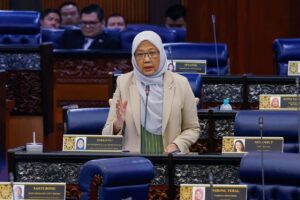KUALA LUMPUR: There is no oversupply of property in Kuala Lumpur and there will be no moratorium on residential projects in the city, says Datuk Seri Dr Zaliha Mustafa.
She said in reply to a question from Young Syefura Othman (PH–Bentong) that the notion of an oversupply of property in Kuala Lumpur is not entirely accurate, as there was a 10.3% decrease in unsold properties compared to previous years.
The Minister in the Prime Minister’s Department (Federal Territories) imposing a moratorium on housing projects would have several negative implications, including a decline in Kuala Lumpur’s Gross Domestic Product (GDP), which relies heavily on the construction sector and property-related services.
Young Syefura had asked if the government plans to impose a moratorium on residential projects in Kuala Lumpur given Department of Statistics projections that the city will reach its peak population in 2031
This is 28 years earlier than the national projection.
To this, Zaliha said that a moratorium would also reduce Kuala Lumpur City Hall’s revenue from development fees and increase property prices and rental rates, potentially forcing B40 and M40 groups to move to the outskirts of the city.
“In reality, the demand for housing in Kuala Lumpur still exists. By 2040, the capital’s population is projected to reach 2.35 million, requiring about 783,000 new housing units,” she said.
“To ensure social balance, 40% of these houses must be affordable and inclusive, catering to senior citizens, persons with disabilities (PWD), youth, and subsidised rental schemes for low-income groups,” she added.
DBKL has proposed a more targeted approach to residential planning, emphasising land use zoning and development intensity, especially in Transit Planning Zones (TPZ) and Transit Influence Zones (TIZ), as outlined in the Kuala Lumpur Local Plan (PTKL) 2040.
Through this approach, all developments can be aligned with the area’s capacity, function, and role, eliminating the need for a moratorium.
Zaliha said DBKL is implementing data-driven development control and capacity-based planning, which is more effective than a moratorium.
This will promote transit-oriented redevelopment (TOD) in strategic locations, control urban sprawl, and provide continuous assessment of infrastructure and public amenities capacity.
DBKL is also strengthening monitoring through digital platforms and a Geospatial Information System to improve development control efficiency.
“To maintain balance between housing supply and infrastructure development, the government adopts the Madani concept, ensuring that roads, public transport, health facilities, and schools are built in tandem with new housing projects. This approach ensures public comfort and prevents congestion, school overcrowding, or delays in basic amenities,” she said.
On the issue of population, Zaliha said that the population of Kuala Lumpur will peak in 2031 and added that it would be the earliest to enter an ageing society phase.
She then said that there is a pressing need to reassess the balance between physical development and urban carrying capacity, especially in terms of infrastructure capacity, affordable housing, environmental sustainability, and residents’ quality of life.






